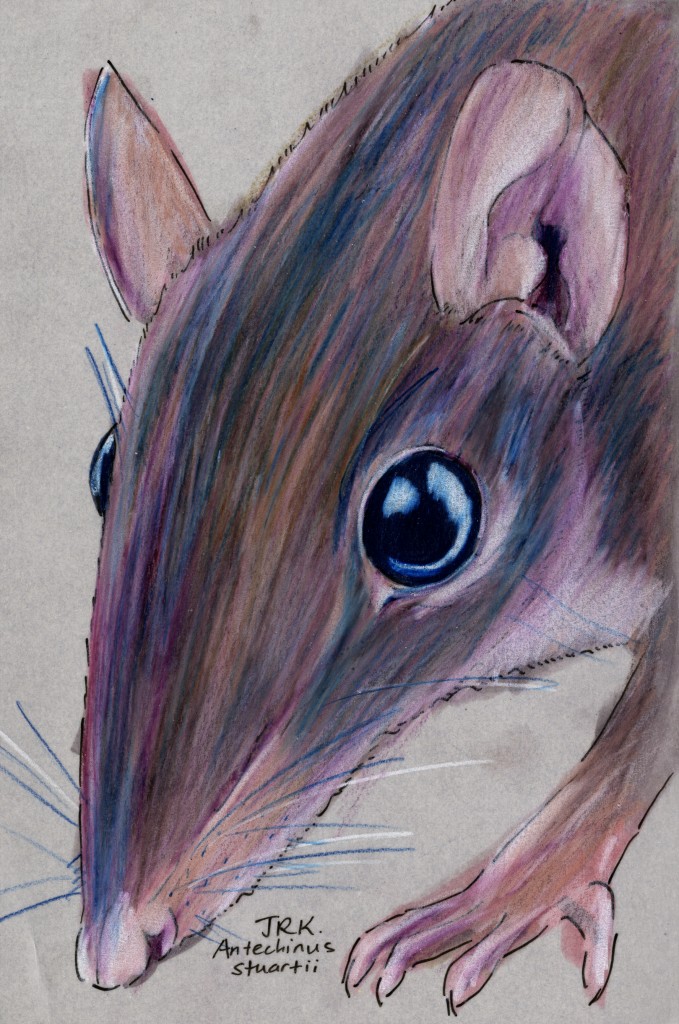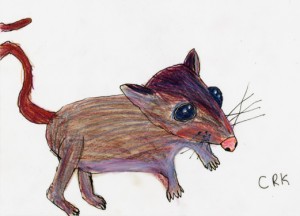Mating Week: Brown Antechinus (Antechinus stuartii)
Every female wants a good father for her babies. Every male wants a good mother for his babies. That’s what life is all about. The more I study other animals, the more I think the meaning of life is: have sex and have babies, and have sex and babies with a mate or mates of good quality. Is there any other reason that anyone does anything?
But different species have different ways of finding the best mates, and within a species, the two sexes have different methods, too. In most mammals, the males aren’t choosy. They just impregnate everyone they can, and hope that their promiscuity will mean the odds are in favor of their finding at least one good mother for their offspring. Most mammalian females are pickier because they have such a large investment in raising the babies, from gestation to nursing and weaning and carrying their young around on their backs as they swing through the treetops. They can’t produce as many offspring, so they have to make sure the ones they have are good ones. Sometimes this means they look for the male who is best at fighting off other males, or they look for the one who can defend them against predators. Sometimes they look for the one with the most attractive pheromones and the prettiest honking noise, like in yesterday’s Gambian epauletted bat.
Females of the brown antechinus species, a mouselike Australian marsupial, look for the males with the strongest sperm. At least in this species, strong sperm means strong babies—babies who survive infancy, anyway. How do they find the best sperm? They mate with everyone who crosses their path and let the sperm fight it out. A typical brown antechinus litter includes the babies of three or four fathers, and studies have shown that the antechinus fathers who sire the most offspring also sire the strongest offspring—the offspring with the best chance of survival. In the end, according to this 2006 Scientific American article about the brown antechinus, this has the same result as mating with just one really good male.
Some of the males don’t end up actually passing on any of their genes, even though they mate just as much as the others. But they don’t care because they’re dead. You see, the brown antechinus mating system is what’s actually referred to as big-bang reproduction. They engage in two weeks of nonstop sex, some sessions lasting 12 hours or so, and then their poor little systems just give out. The stress of all that mating causes the males to suffer immune suppression and infection and internal bleeding and they all die before their first birthday. The ones with the strongest sperm father babies that will be born after their dads are gone, and the ones with weak sperm die in vain. The females survive long enough to give birth and nurse and wean, but they don’t live much longer than a year themselves. Then the next generation repeats the whole thing the following fall, and so it goes on and on and on.
Coco (age 12) drew a brown antechinus, too:



“In rating beasts I’d like to be, I find that antechinuses,
Score not a single plus and have a multitude of minuses.”
(http://www.australianmammals.org.au/memberSection/Newsletters/AMS%20Newsletter%20-%20April%202009.pdf)
Oh wow, Albertonykus, that’s great! And instructive, as it helps me remember how to pronounce antechinus! I had been saying it all wrong. Here is the full poem from the newsletter in case anyone is too lazy to download the PDF:
Great drawing, Coco!
Kate, Coco says thanks!